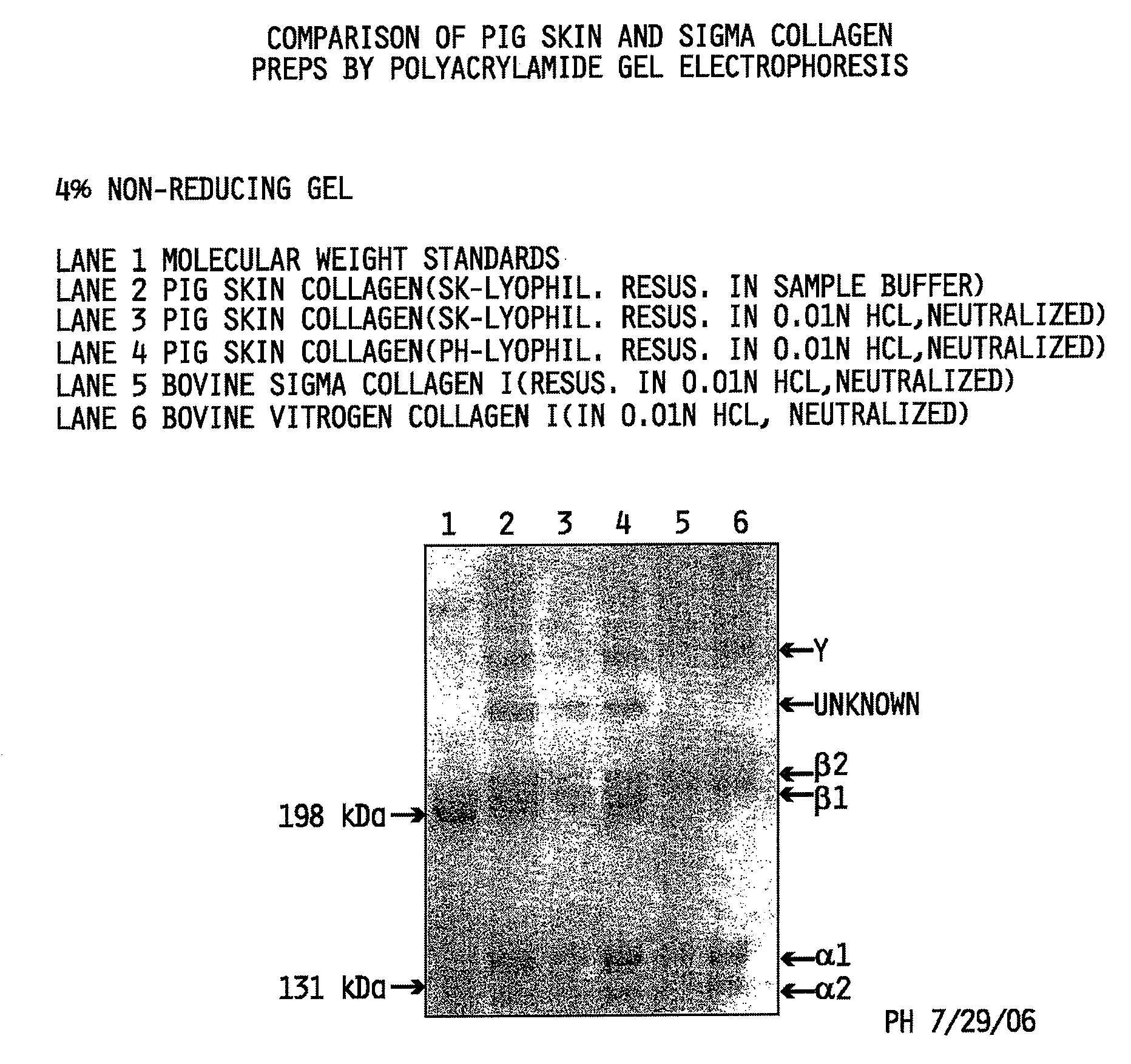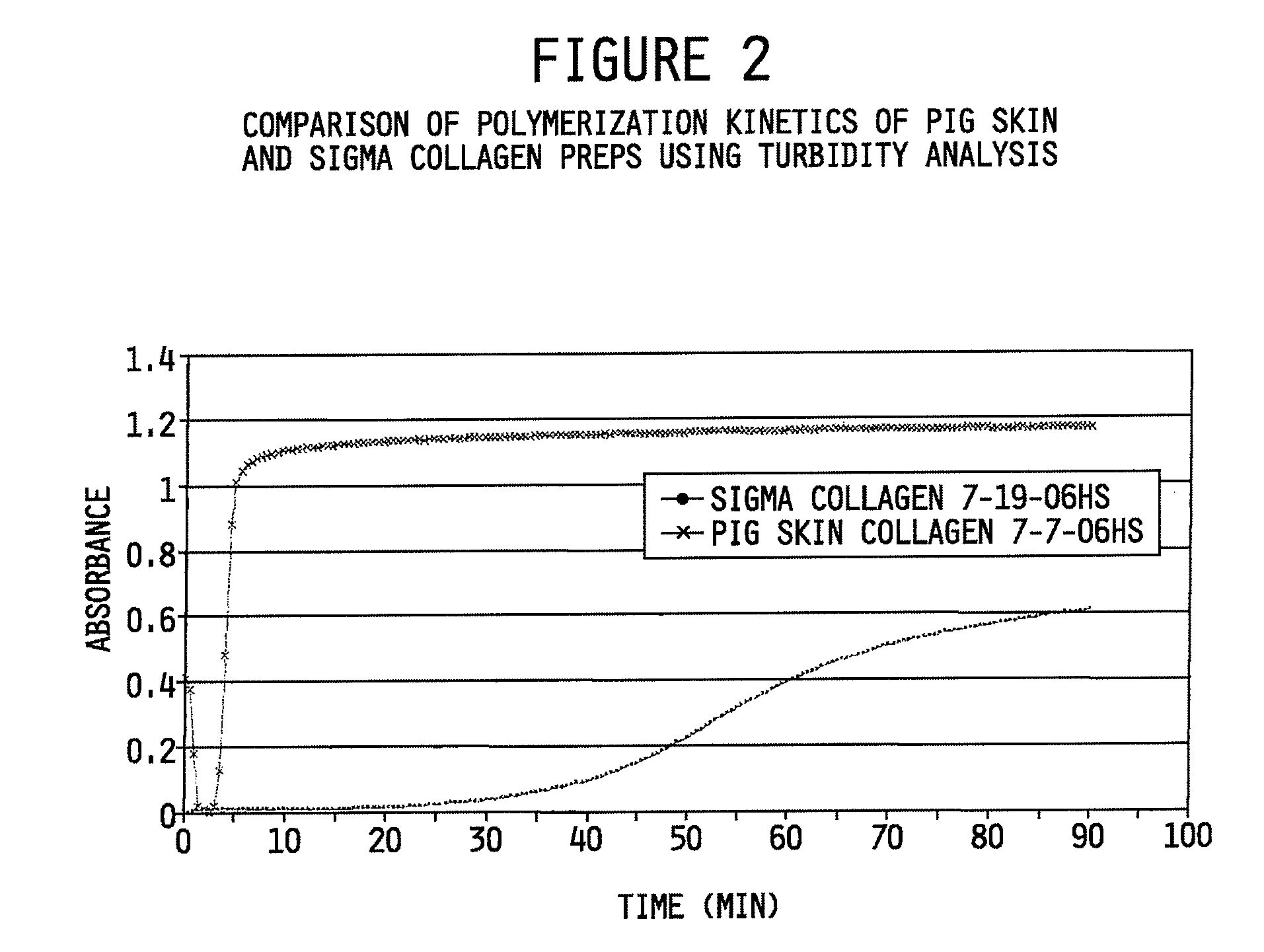Collagen preparation and method of isolation
a technology of collagen and collagen fibrils, which is applied in the field of collagen compositions, can solve the problems of more difficult to achieve with existing intact or processed collagen fibrils from natural sources and with collagen preparations from commercial sources, and achieve the effects of facilitating hierarchical assembly of collagen fibrils, enhancing mechanical properties, and increasing polymerization ra
- Summary
- Abstract
- Description
- Claims
- Application Information
AI Technical Summary
Benefits of technology
Problems solved by technology
Method used
Image
Examples
example 1
Collagen Isolation
[0110]To prepare collagen, skin was harvested from pig immediately following euthanasia and was washed thoroughly with cold water. The skin was stretched out and pinned to a board and stored at 4° C. The hair was removed with clippers. The dermal layer of the tissue was isolated by separating and removing the upper epidermal layer and the lower loose fatty connective layers. This removal was readily achieved by scraping the tissue with a knife or straight razor. The tissue was maintained at 4° C.
[0111]The resulting dermal layer tissue was washed in water and then cut into small pieces (approximately 1 cm2) and was frozen and stored at −80° C. The frozen skin pieces were pulverized under liquid nitrogen using an industrial blender or cryogenic grinder. Soluble proteins were removed by extracting the pig skin powder (0.125 g / ml) with 0.5M sodium acetate overnight at 4° C. The resulting mixture was then centrifuged at 2000 rpm (700×g) at 4° C. for 1 hour. The supernat...
example 2
Polyacrylamide Gel Electrophoresis
[0116]Interrupted gel electrophoresis was performed to compare the protein composition of the collagen preparations made in accordance with the methods described herein to commercially available type I isolated collagen obtained from Sigma-Aldrich, St. Louis, Mo. (Sigma Cat. No. C3511) and pepsin-solubilized collagen from INAMED (Fremont, Calif.) sold under the product name PureCol™. Interrupted gel electrophoresis was performed according to Sykes, et al. The estimation of two collagens from human dermis by interrupted gel electrophoresis. Biochem. Biophys. Res. Commun. 72:1472-1480 (1976), incorporated herein by reference. Sodium dodecylsulfate polyacryamide gel electrophoresis (SDS-PAGE) was performed according to the method of Nielsen, et al. Measurements of molecular weights by gel electrophoresis. Methods in Enzymology, vol. 48, Hirs and Temasheff, Eds., Academic Press, New York, pp. 3-11 (1978), incorporated herein by reference.
[0117]The evalu...
example 3
[0120]The polymerization kinetics of the pig skin collagen preparation made in accordance with the methods described herein were also compared to commercially available Sigma Type I collagen. For this evaluation a spectrophotometric turbidity analysis assay for determining polymerization kinetics of collagen, well-known to those skilled in the art was used. The assay was performed in accordance with Comper, et al. Characterization of nuclei in in vitro collagen fibril formation. Biopolymers 16:2133-2142 (1977) and Brightman, et al. Time-lapse confocal reflection microscopy of collagen fibrillogenesis and extracellular matrix assembly in vitro. Biopolymers 54:222-234 (2000), each incorporated herein by reference. The time-course of polymerization was monitored in a Lambda 35 UV-VIS spectrophotometer (Perkin-Elmer) equipped with a temperature-controlled, 8-position cell changer as described previously by Brightman et al., 2000.
[0121]FIG. 2 shows the time-depende...
PUM
| Property | Measurement | Unit |
|---|---|---|
| concentrations | aaaaa | aaaaa |
| concentrations | aaaaa | aaaaa |
| shear storage modulus | aaaaa | aaaaa |
Abstract
Description
Claims
Application Information
 Login to View More
Login to View More - R&D
- Intellectual Property
- Life Sciences
- Materials
- Tech Scout
- Unparalleled Data Quality
- Higher Quality Content
- 60% Fewer Hallucinations
Browse by: Latest US Patents, China's latest patents, Technical Efficacy Thesaurus, Application Domain, Technology Topic, Popular Technical Reports.
© 2025 PatSnap. All rights reserved.Legal|Privacy policy|Modern Slavery Act Transparency Statement|Sitemap|About US| Contact US: help@patsnap.com



